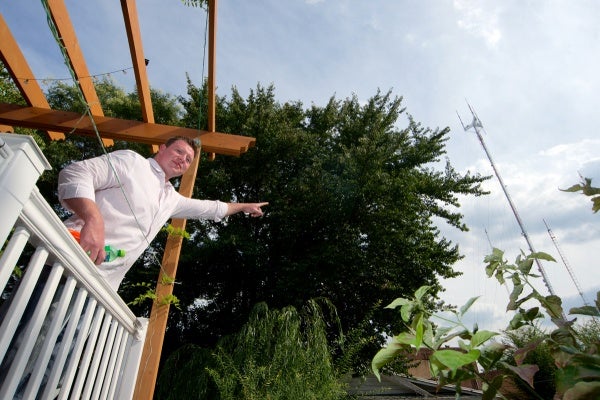Roxborough’s antenna farm has some neighbors hearing ‘creepy’ (but safe) voices
At their home on Harmon Road in Roxborough, Shane and Jocelyn Brody hear voices through the pipes in the basement.
In their backyard, Mexican melodies emanate from their neighbor’s metal fence. Occasionally, they pick up what must sound like heavenly messengers—but is actually Christian programming that they receive through their rain spout.
It’s not exactly Poltergeist, but Jocelyn Brody says there is a certain “creepy” factor.
What’s the frequency?
The young couple moved into the house that previously belonged to Shane’s aunt three years ago.
“She told me that music would play out of the ceiling fan sometimes,” Shane recalled. “She even heard it coming from her toaster oven.”
The Brodys attribute the rogue airwaves to their proximity to the Roxborough antenna farm—the crop of some two dozen towers that rise on one of the city’s highest elevations. They are visible for miles around, particularly at night when their blinking red lights warn low-flying aircraft of their presence.
The towers, some exceeding 1,000-feet tall, are used by most of the city’s television and radio stations for their transmissions.
The Brody home is a few hundred yards from the antenna farm.
Wide receiving zone
Several metal towers seem to grow out of their neighbors’ backyards across the street. Other residents of Harmon Road get the same interesting reception in their houses.
The broadcast noise is more an annoyance than anything else, Shane Brody said.
When they’re watching a TV program on one channel, their speakers can pick up another. The unwanted waves ebb and flow. They are loudest in the basement walls and ceiling, particularly in the morning. Outside, the ghost stations come in clearest and loudest on hot summer days.
The Brodys installed a surround-sound system with a multi-zone receiver so Shane could listen to the Phillies games on the deck while Jocelyn watches something else inside. The multi-zone reception apparently included the Twilight Zone.
“The problem got 10 times worse,” Shane said. “We would have to kill one of the zones to make it better. I haven’t used the surround-sound for a year and a half.”
Not a new issue
Before the Brodys moved in, Harmon Street residents had a company test the neighborhood for any dangerous effects of the looming towers, and concerns over the concentration of broadcast antennae goes back many years. Shane was told the testing found that the towers were not hazardous.
Recently, administrators of the Green Woods Charter School being erected a block away from Harmon Road on Domino Lane consulted the Carl T. Jones Corp., a Springfield, Va.-based firm that provides communications engineering services to the broadcast industry and local governments.
It also provides interference analyses and evaluates the impact of new technologies.
CTJC found no health concerns for the students and staff who will be attending Green Woods and no reason to expect any effects on the equipment used in the school’s science and computer labs.
Herman Hurst, general manager of technical operations for CTJC, said neighborhoods throughout the country have raised questions about broadcast and cellular towers.
“Normally, unless you’ve got the antenna on the parapet of your house, you’re not going to have levels that are harmful to humans,” Hurst said.
However, he wasn’t surprised to hear about the experiences of the Brodys and their neighbors.
“It can happen under various circumstances,” Hurst said. “It doesn’t even have to be extremely high fields [of transmission] to see this happen. The Roxborough towers do serve many high-powered FM and AM stations.”
The solution?
“This usually happens because of poor grounding of the electrical system or plumbing in a house,” Hurst said. “With proper grounding, it usually goes away.”
The Brodys’ home, and those of many of the neighboring homes on Harmon Road, were built in the mid-1930s, using metal pipes for the plumbing and knob and tube electrical wiring, which was discontinued after the ’30s.
Neighbors up the street living in newer townhomes—with plastic pipes and new wiring—have not had any issues with weird radio or TV reception, Shane said.
The Brodys have switched over to some plastic piping, and their electrician has updated about 30 percent of their wiring. Shane said he will look into how to properly ground both systems.
A lifelong Roxoborough resident, he said the strange transmissions have “never made us think of moving. It’s just more of an interference—no pun intended.”
NewsWorks has partnered with independent news gatherer PlanPhilly to provide regular, in-depth, timely coverage of planning, zoning and development news. Contact Alan Jaffe at ajaffe@planphilly.com.
WHYY is your source for fact-based, in-depth journalism and information. As a nonprofit organization, we rely on financial support from readers like you. Please give today.













